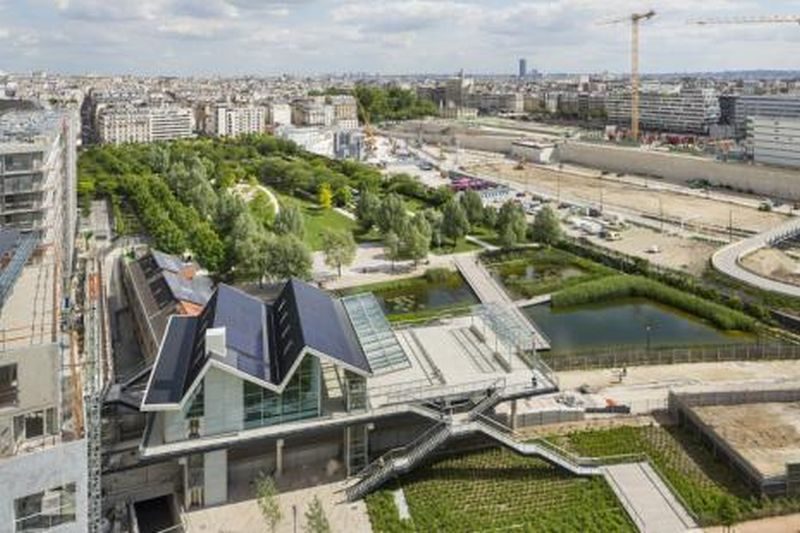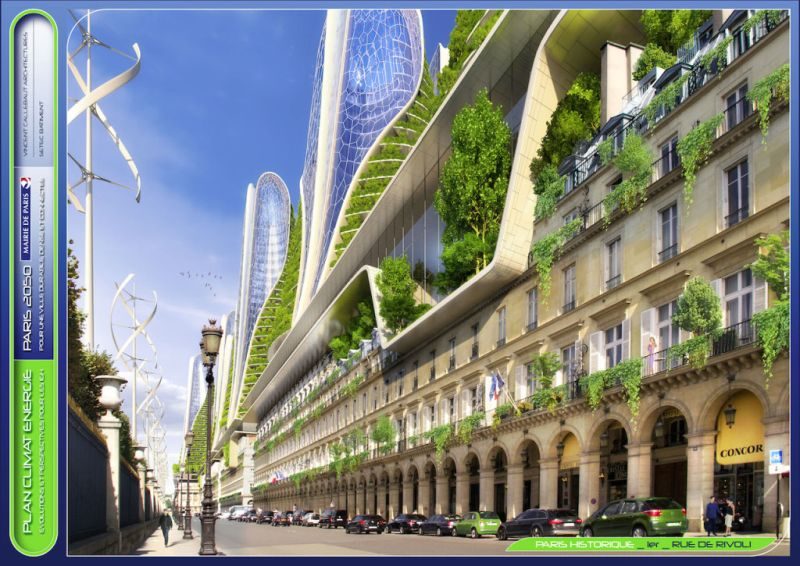Paris made news in 2007, when it adopted the climate action master plan. The city set goals to reduce/eliminate greenhouse gas emission over and above the goals outlined by The EU. The ‘Paris Region’ is being developed in an eco friendly way to accommodate 13 million people. The plan is to construct 100 eco neighborhoods which will have about 50,000 eco homes. Offices, residences, transport, eco industries would all experience the shift to eco-friendly systems. One example is the transformation of a train yard into an eco-friendly urban park, which would be surrounded by buildings which are energy efficient. Read on to find out how Paris is on the way to being a sustainable city of the future:
Paris: Sustainable city of the future
 Image Source : clichy-batignolles.fr
Image Source : clichy-batignolles.fr
Paris or the Paris region is doing all it can to be the most sustainable city of the future. Let’s take for example the development of the Clichy-Batignolles, which is the first tangible evidence to establishing an eco-community of the future.
Features of the Clichy-Batignolles
The train yard comprising of environment friendly buildings and green areas would employ approx 12,000 people and provide homes for 7,500 people. The development is expected to be completed by the year 2020. At its centre is an amazing 40,000 sq m park. The entire cost of the project which uses the latest eco-friendly technology is approx 505.7 million Euros.
Housing, theatre, judicial centre, cinema, shops and public facilities are being built in the 495,000 sq m area. 1,400 housing units are complete and the rest are expected to be completed in 2020. The district received several Green prizes from the government and the Paris smart city project won European funding for creating first smart grid in the city. Some of the most interesting green features of Clichy Batignolles are:
1. Passivhaus design
 Image Source : clichy-batignolles.fr
Image Source : clichy-batignolles.fr
A sustainable city of the future has to have energy efficient structures. This has been demonstrated in the Passivhaus design of Clichy Batignolles. The Passivhaus concept is to construct buildings which require only 15 Kw Hours energy to heat a sq m floor space in one year. The total energy consumption is less than 50kWh sq m floor space every year.
While establishing an eco-community such as Clichy-Batignolles, the designers built taking into consideration the direction of the sun. All the buildings face south, and are insulated, enabling them to retain the captured warmth and heat from the sun. All the buildings have been made from renewable material, and PVC etc have not been used.
2. Solar photovoltaic roof
The project which is one of the projects to turn Paris into sustainable city of the future has planned to install 40,000 sq m solar photovoltaic roofs which will generate 4,500 megawatt hours every year. This solar electricity will supply up to 85% of the energy needs, and geothermal energy will supply 83% of energy required for heating water and space heating.
This eco-friendly technology will enable Clichy-Batignolles to be carbon neutral. Other cities and metros can take the example of this project to develop into carbon neutral, energy producing, zero emission spaces.
3. Martin Luther Biodiversity Park
 Image Source : landezine.com
Image Source : landezine.com
Dedicated to Martin Luther, the park would have 500 species of plants. These plants would be planted around the biotope basin and wet ditch, a part of sustainable drainage design. The permeable surfaces are linked to many underground reservoirs to conserve water. The rainwater runoff too is reduced and the rainwater harvesting would help to irrigate the park, and minimize pollution.
Numerous plants have been planted along the lanes of Clichy, as well as the landscaped cores, private gardens in order to grow flowers and food. The 16,000 sq m green roofs are amazing and cool down the buildings as well as clean the air. Paris’s ambitions to build sustainable city of the future will be realized with eco friendly features such as solar energy, green roofs etc. Composting facilities will help to transform organic waste into useful organic manure.
The park is a part of some green spaces which thread through Paris, including Bois de Boulogne, Parc Monceau, and the Montmarte and Clichy cemeteries.
4. Ultra modern waste collection and disposal system
Except glass, all waste is collected through a pneumatic network located underground. The waste is sucked into the collection terminal where it is distributed to recycling and treatment centers. This simple innovation which cuts down on collection of waste via garbage trucks, cuts down on 42% greenhouse emissions, 98% CO emission, 90% particulate emissions and 86% nitrogen oxide emissions. When features such as this underground waste suction innovation become a feature in most neighborhoods of Paris, then Paris will truly become a sustainable city of the future.
5. Transport
 In Clichy and other eco neighborhoods planned in the city, cars are discouraged. People can walk, cycle and take the metro, local trains and trams. A Paris Palace of Justice has been planned, which will be as tall as 160 meters.
In Clichy and other eco neighborhoods planned in the city, cars are discouraged. People can walk, cycle and take the metro, local trains and trams. A Paris Palace of Justice has been planned, which will be as tall as 160 meters.
By 2050, Paris would become a smart city with a difference – the structures would be plant embedded and provide a green relief to the innovative architecture design. Some of the incredible structures which have been planned would reduce urban heat island phenomenon. Take a look:
6. Rue de Rivoli Mountain Towers
It would be a group of 15 hydrodynamic, solar and green towers. These towers would use plants to bio condition the buildings.
7. Montparnasse – Photosynthesis Towers
 Image Source : hyperallergic.com
Image Source : hyperallergic.com
These towers would be adorned biofacades powered by algae. Photosynthesis towers would be the central attraction of the piezoelectrical landscape.
8. Petite Ceinture – anti-smog towers
These out of the world towers will be part of 5 light activated towers, creating an eco friendly corridor in Paris’s 14th district.
9. Massena – Bamboo Nest Towers
 Image Source : cdn.luxuo.com
Image Source : cdn.luxuo.com
The eco friendly design will be encased within bamboo meshes, where vertical food gardens and orchards would be grown. Thermodynamic design of these buildings and other green buildings will transform Paris into Paris smart city.
10. Porte De Lilas – Honeycomb towers
This complex will receive energy from a community run energy cooperative.
11. Porte d’Aubervilliers- Farmscrapers
 Image Source : gbplusamag.com
Image Source : gbplusamag.com
Vertical farms as never before- three stacked one on top of the other to cultivate vegetables right inside the city.
All these incredibly advanced eco friendly constructions planned in Paris seem set to propel Paris into the most sustainable city of the world.



